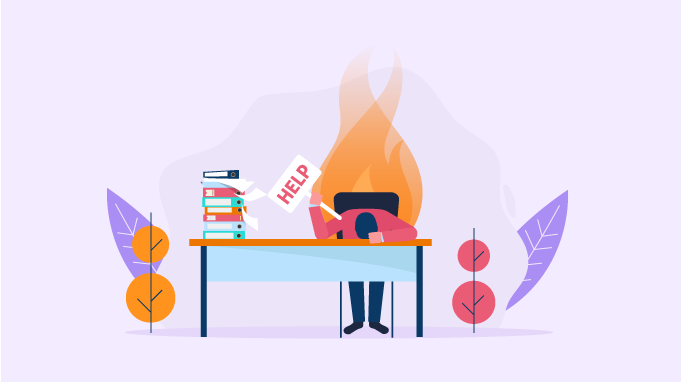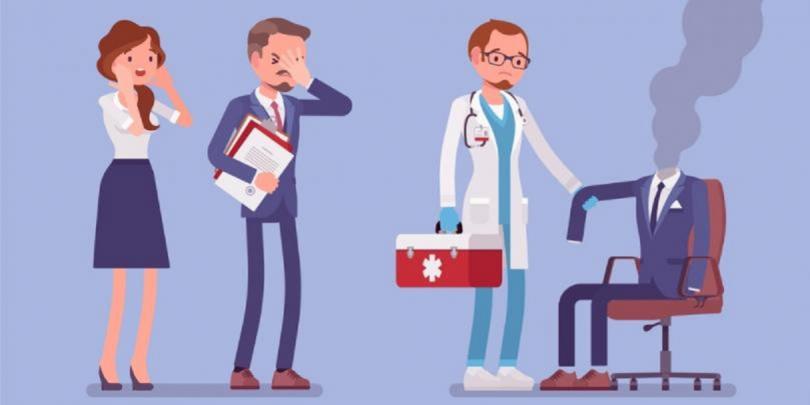It used to be that working from home in pajamas and cozy clothes was the real perk of working from home. The thought of cuddling with your pet while on a work call sounded wonderful. But lurking in the midst of working from home is a harmful topic, employee burnout.

So what if you start your day sitting on your couch or still in bed, checking your mail, catching up on your favorite web series, doing some work, grabbing lunch while watching a conference, and working some more?
When you realize it’s past 5:00 p.m., it may be too late? How would you deal with a day when you feel you were not productive enough and wish to make up for it by working late at night? Can you imagine what it would be like if your laptop became an extension of yourself, at all times?
Your professional and private lives have become entwined in such a way that the lines between the two have become blurred beyond recognition. Do you recognize this?
15 hours per week! In the aftermath of the pandemic, employees are reporting more time working since everyone took the work home and remote work flourished. It’s 3 hours a day for every single day.
The more you work and the more you separate your personal and professional lives, the more likely you are to become exhausted, stressed, and burned out. Employee burnout and stress related to the pandemic have both been directly linked to the pandemic.
How does burnout affect a person? Burnout occurs when workplace stress is not managed. A vacation will not help you shake off chronic fatigue. A fatigue that you will not be able to shake off by taking a break.
What causes burnouts?
Burnout is caused by chronic stress. The longer you are mentally stretched, the more likely you are to experience burnout.
Burnout is still not a popular term, but there have been some recent attempts at describing it.
Pandemic stress has played a key role in causing employee burnouts. A large part of the problem stems from people being forced to learn on the fly. They are forced to give up their comfort zones and old habits.
73% of employees have experienced burnout at some point in their careers, according to reports.
In the early days of the Covid, employees found that the methods that worked for them have stopped working. Aside from trying to fit all aspects of their lives in one space, they are also trying to fit their personal, professional, and social lives into one space.
Work stress, anxiety about job loss, demands from work-from-home, excessive workload, and financial worries have all contributed to a crisis of burnout during these troubling times. And the situation is getting worse with every passing day as we realize there is no end in sight.
What Are The Symptoms Of A Burnout?
Stress leads to burnout, as we have discussed. But how can you tell when you’re suffering from burnout?
As long as we are under continuous stress, our brains automatically switch to ‘survival mode,’ and survival mode does not allow us to think about our aspirations or our responsibilities.
There is a tendency to lose track of things- especially stuff like messages, notifications, deadlines, and projects. Procrastinating and avoiding work are common behaviors among burned out individuals.
In addition to being sleep-deprived and frazzled, people are often obsessed with work. Even in cases when they lack the driving force and motivation to actually go to work. People who are burned out typically experience the following symptoms:
- Being distracted and having difficulty concentrating
- Reduced professional effectiveness due to not completing work on time
- Feeling irritable, sad, or angry as a result of mood changes
- Being sad, feeling hopeless, losing interest in the things you once enjoyed, or feeling fatigued can indicate a depressive disorder
- Apathy or discouragement about your work, lack of motivation
- Having difficulty falling asleep, getting poor sleep, or experiencing insomnia
- Alcohol consumption that is excessive or excessive drinking as a coping mechanism
- If you experience physical symptoms such as pain in your chest, headaches, increased illness, dizziness or fainting, or stomach cramps
- In a denial or irritation state
- Uncertainty, nervousness, or feeling overwhelmed
- Experiencing a depletion or exhaustion of energy
- Increased mental distance from one’s job in addition to feelings of negativity or cynicism during the job search process

How Can You Keep Burnout Away?
Taking time off is the impulsive first thing to do when you’re burnt out. And it’s worth it to change the scenery from time to time. Nonetheless, burnout is often a chronic condition, one that won’t disappear until we change the conditions that brought it on.
Establish a schedule that works for you

Everyone works best at different times, so remote workers need flexibility in scheduling their work time. There are other important matters that require a person’s attention, such as cooking dinner or watching children’s naps, and it’s important to respect those responsibilities.
It is acceptable for employees to let their team know if they might take longer than usual to respond during these budgeted timeslots in order to maintain reasonable expectations.
Define clear boundaries between work and home
You must become self-aware so you can switch from being the ‘home person’ to the ‘work person’. You can dramatically improve your work-life balance by making your home office door lockable during office hours and turning off emails and work notifications when you are having dinner with the family.
Keep your controllables in check
When it comes to the uncertainty of the pandemic, there is only so much you can do. It is normal to feel stressed and anxious. Routine and lifestyle are the things you can change, however.
Healthy routines will do your body a lot of good – perhaps you can replace the daily commute to work with a walk in the park. Don’t consume your lunch and dinner in front of the computer.
What Companies Should Do To Manage This Problem?
Stress and employee burnout can be effectively reduced through the provision of social support in the workplace. The fact that you don’t all work from the same office structure any more doesn’t mean that free-flowing conversations and office friendships must end.
Create remote ‘water-cooler’ time
Having implemented a Work-From-Anywhere policy, the company went completely remote after the pandemic. My team meets weekly for fun group calls to keep the conversations going and to avoid social isolation.
We just hang out and talk about what’s been going on. We can stay in touch and help each other out this way. Plan regular meetings around the water cooler with coworkers. In addition, socially distanced meet ups can be amazing if they can be arranged!
In addition to improving your own sense of control, belonging, and self-esteem, checking on others can also make you feel great. It’s a win-win situation!
Offer mental health benefits
It is an employer’s responsibility to care for the mental health and wellbeing of employees in a number of ways, including covering gym or health club memberships, as well as reimbursing meditation apps.
There are a number of organizations offering new mental health benefits that were previously lacking, such as employee assistance programs and telemedicine screening.

Ensure realistic workloads
It is an employer’s responsibility to care for the mental health and wellbeing of employees in a number of ways, including covering gym or health club memberships, as well as reimbursing meditation apps.
There are a number of organizations offering new mental health benefits that were previously lacking, such as employee assistance programs and telemedicine screening.
Ensure realistic workloads
Overwhelming workloads and unreasonable expectations are both often cited by burnout survivors as major contributors. It implies a deeper problem- that people don’t finish the work they put in despite working extra hours. The obvious solution for evenly spreading workload is to remove the burden from your employees.
Be aware of signs of burnout (exhaustion, anxiety, inability to meet daily requirements) so you can know when to reduce demands and expand resources.
Encourage vacations and flexibility
In order to increase employee productivity, employees should not be required to work overtime. Essentially, it means resting and recharging employees. Consider vacation-friendly policies and replacing micro-managing with at least some control over employee schedules.

Empathetic leadership
If companies ignore the alarming rate of employee burnout during the pandemic, they run the risk of damaging their brand and bottom line. In addition to productivity levels, burned-out employees can negatively affect job satisfaction, employee engagement, and retention rates.
An employer can’t really diagnose employee burnout on their behalf. It is possible to acknowledge the problem, and empower a culture of empathy and plenty of communication so that your employees feel like they have somebody who cares for them. Be aware of any problems.
A trusting work culture makes them much more likely to recognize the symptoms of stress and burnout and reach out to you for support. A program for managing the employee experience will help you understand and resolve issues.
When you let your people know that they are okay with having problems, there is nothing better you can do for them. They can be forthcoming and ask for support if you give them the space. Provide your employees with the resources they need to cope when times are tough. Set up a system of support for them.